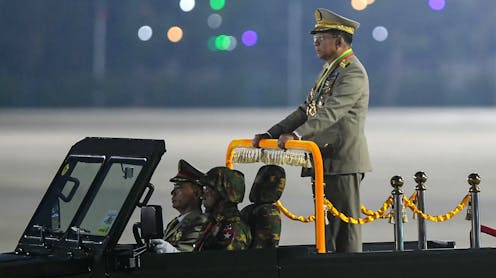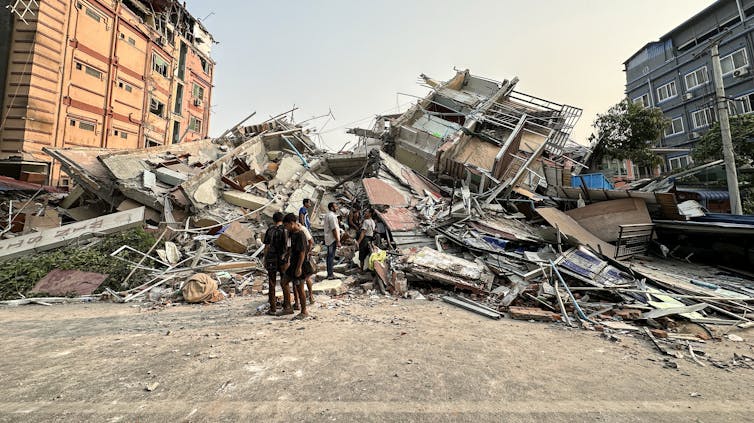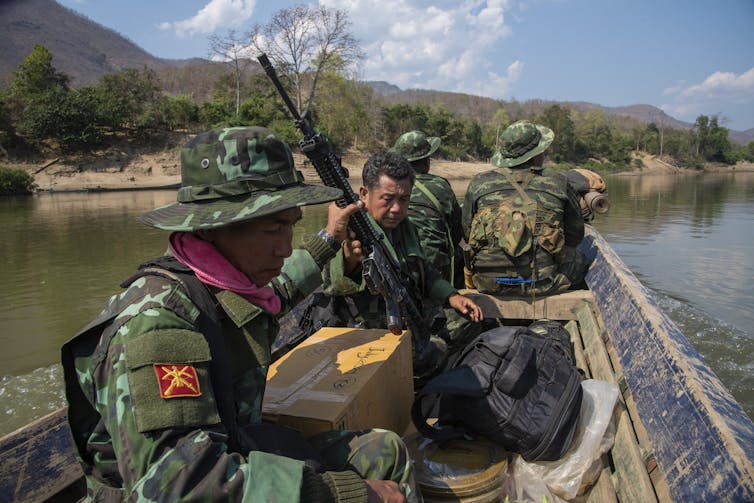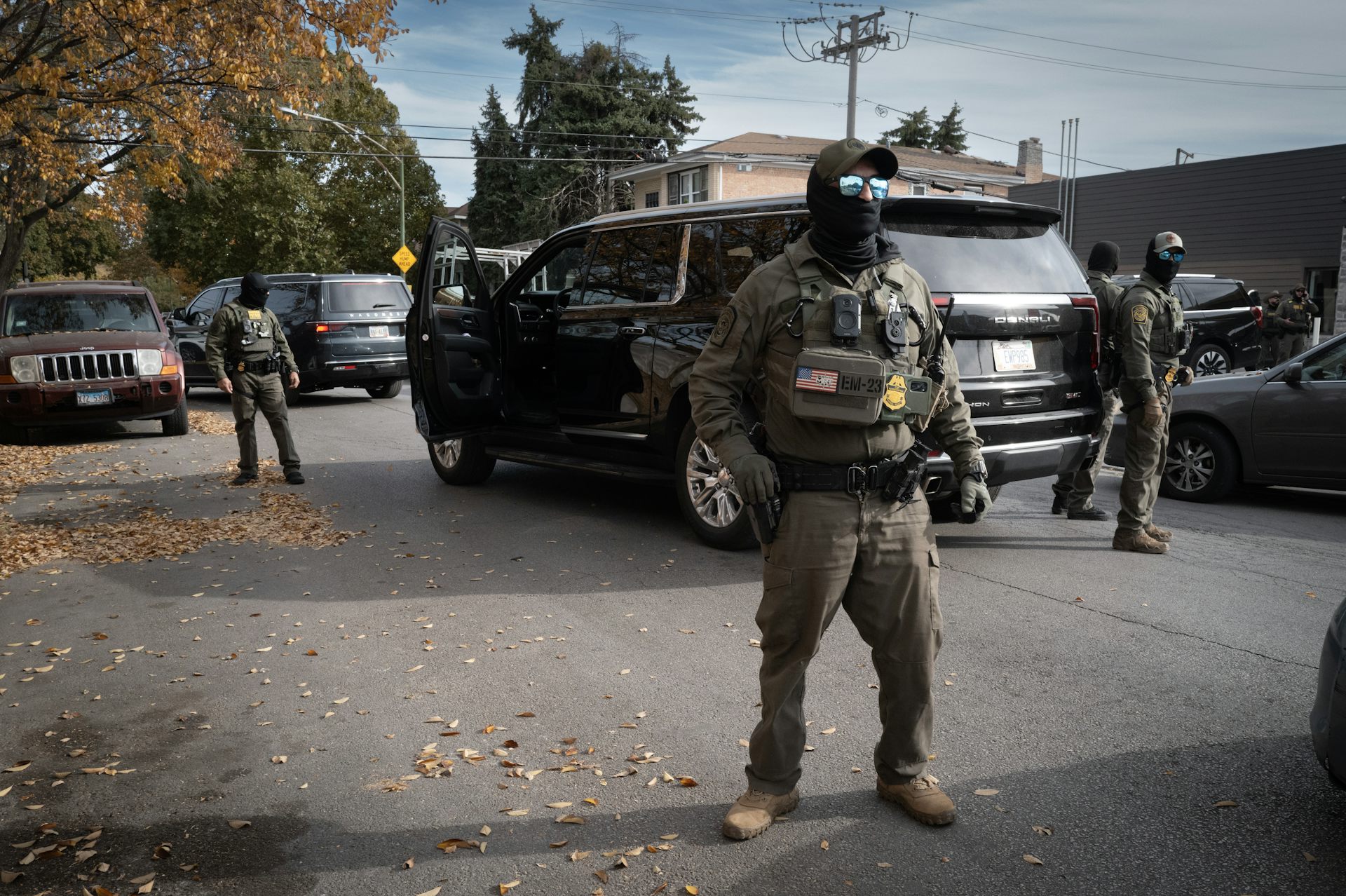Myanmar military’s ‘ceasefire’ follows a pattern of ruling generals exploiting disasters to shore up
Thousands were killed in 7.7 magnitude earthquake. Yet military generals were slow to agree to pause in civil war fighting, and continued airstrikes.

After a 7.7 magnitude earthquake struck Myanmar on March 28. 2025, the country’s military and the myriad resistance groups fighting a yearslong civil war faced international calls for an immediate ceasefire. A pause in the fighting would enable vital aid to enter the major quake zones and allow rescuers to assist victims in a disaster that has already killed more than 3,000 people.
The first to heed the call was the opposition National Unity Government, which unilaterally announced a two-week pause on attacks by its armed wing, the People’s Defense Force, on March 29. The Three Brotherhood Alliance – a coalition of three ethnic resistance groups: the Myanmar National Democratic Alliance Army, the Ta'ang National Liberation Army and the Arakan Army – likewise agreed to a temporary truce.
But Myanmar’s military demurred. Just hours after the quake, as rescuers continued to dig through rubble in search of survivors, the generals ordered airstrikes on enemy positions in Shan state and Karen state in the country’s east – a decision that United Nations special rapporteur Tom Andrews described as “nothing short of incredible.”
The generals eventually yielded to pressure late on April 2 – some five days after the earthquake hit – announcing that they would halt fighting until April 22. But the statement appeared to be hollow, with reports just a day later that the military’s bombing campaign and ground offensive were continuing unabated in Kachin state in Myanmar’s north.

As an expert on the political history of Myanmar, I believe the behavior of the country’s military is of no surprise. The generals who have had a grip on the country for much of the past six decades have a track record of exploiting disasters for political gain. Weakened by years of entrenched civil war, they are now seeking an opportunity in the earthquake to rehabilitate their image overseas, while consolidating power at home.
From disasters to elections
Myanmar’s ruling junta has tried this tactic before. In 2008, a week after the deadly cyclone Nargis killed more than 100,000 people in Myanmar, the military proceeded to hold a constitutional referendum that would guarantee the military’s control of government by reserving 25% of all parliamentary seats for officers while requiring 75% of votes for any future constitutional reform. It also allowed for the military to take over the country “in the event of an emergency.”
The referendum took place while much of Myanmar was still reeling from disaster, yet the junta announced a 98.12% turnout, of which 92.48% voted in favor of the new pro-military constitution.
It paved the way to elections in 2010, which the military’s Union Solidarity and Development Party won. Though that vote was boycotted by the opposition National League for Democracy, or NLD, Washington had by then signaled a shift in policy toward “pragmatic engagement” with the then-ruling junta. This U.S. shift forced the recalcitrant NLD to cooperate in subsequent elections, giving legitimacy to a process that was stacked in favor of the generals.
Using a fig leaf of legitimacy
The latest disaster comes as the junta is again attempting to push for elections. Just a day before the earthquake, Myanmar’s military chief, Min Aung Hlaing, confirmed plans for a December national vote and called on opposition parties to participate.
But the proposed election in Myanmar is widely seen as a face-saving strategy for both the Myanmar military and, I would argue, an international community that has done little of any significance to end the civil war. In this context, elections would allow the generals to cover their 2021 power grab with a fig leaf of legitimacy.
The entrenched civil war that was sparked by that military takeover – a coup that ended a 10-year experiment with limited democracy – derailed the military’s initial plan to return to full control of the country.

Four years of fighting a broad-based opposition that includes ethnic minority groups like the Karen National Union, Kachin Independence Army, Arakan Army, Ta'ang National Liberation Army, Myanmar National Democratic Alliance Army, People’s Defense Force and Bamar People’s Liberation Army has taken its toll on the military.
It has lost territorial control in many regions to the myriad resistance groups. Internationally, it has become more isolated through sanctions, and its largest trading partner, China, concerned over instability on its border, has slowed investments as it tries to play all sides of the conflict.
In desperation, the generals have resorted to forced conscription for foot soldiers, while looking to Russia for arms and investment.
The failure of the generals
What the military desperately needs now is a lifeline and a civil war exit plan. The earthquake could provide both, with a ceasefire – no matter how badly observed – providing a cover for allowing for a national vote.
But as has been evident in the days surrounding the announcement of a truce, the military is likely to exploit the disaster to weaken the resistance along the way. It has said that it will take “necessary” measures against any resistance group found to be regrouping or attacking the state during the ceasefire. Yet it has reportedly continued its own offensive.
The earthquake has revealed the failures and brutalities of the military in other ways, too. In the aftermath of the disaster, the military shut down private clinics and hospitals in badly hit Mandalay for allegedly employing rebel doctors and nurses who were treating members of the resistance. As it was, many health care workers have been in hiding since the coup, and young people who could have been on the front lines of relief efforts have either joined the resistance groups or fled the country.
The earthquake will also further hurt a Myanmar business community already suffering from the pullout of international businesses after the 2021 coup.
On unsecure foundations
Yet, the military may be hoping that it can use the disaster to rebuild its brand overseas. The surprise announcement of a ceasefire by the generals is part of that process. So, too, is the decision to allow in international rescue teams, after initially blocking relief workers from entering the country. It is the military’s way of showing willingness to cooperate with the wider world.
In short, disaster diplomacy has kicked in for Myanmar’s military, as it did after 2008’s Cyclone Nagris. That earlier cyclone provided an opportunity for the junta to present a different face to the international community. Elections were held, not once, but twice – encouraged by the U.S. and others – and investments rushed into Myanmar as the country was touted as “Asia’s next Tiger.”
But the foundations of military-backed reform in Myanmar were built on fault lines that cracked and crumbled amid the 2021 coup. The military’s exploitation of the 2025 earthquake will, I fear, result in similar ends.
Tharaphi Than does not work for, consult, own shares in or receive funding from any company or organization that would benefit from this article, and has disclosed no relevant affiliations beyond their academic appointment.
Read These Next
As a former federal judge, I’m concerned by a year of challenges to the US justice system
A university president who’s a former federal judge looks at the rule of law and the Trump administration’s…
Time banks could ease the burden of elder care and promote connection
A diverse team of researchers, concerned that the global elder care crisis cannot be addressed by the…
The dystopian Pottersville in ‘It’s a Wonderful Life’ is starting to feel less like fiction
Frank Capra’s dark vision of corruption and greed highlights both the dangers of concentrated power…






